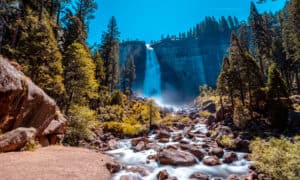Located in Pennsylvania‘s Pike County, Raymondskill Falls are part of the Delaware Water Gap National Recreation Area shared by Pennsylvania and New Jersey. At 150 feet, Raymondskill Falls is the tallest waterfall in Pennsylvania.
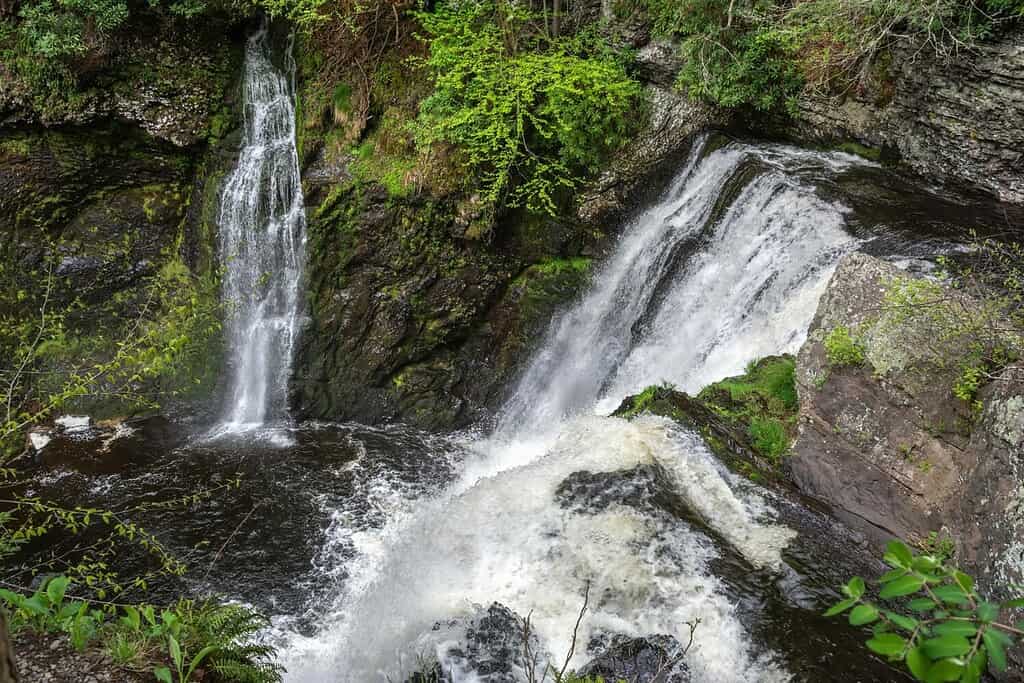
Raymondskill Falls is the tallest waterfall in Pennsylvania.
©Alizada Studios/Shutterstock.com
The “water gap” in this region is formed by the Middle Delaware River’s passage between low forested mountains and rocky mountain ridges. After the river leaves this national recreation area, it flows another 200 miles to Delaware Bay and the Atlantic Ocean in Wilmington, Delaware.
The Delaware Water Gap National Recreation Area is a federally-protected natural area that sits in the midst of the most densely populated area in the United States. There are over 150 miles of hiking trails in this national recreation area. Some are wheelchair accessible, such as the Dingmans Falls boardwalk trail. Others are rigorous hikes, such as the Mount Tammany Red Dot Trail. The Appalachian Trail also passes through the park.
And then, there is the Raymondskill Creek Trail which leads hikers to Pennsylvania’s tallest waterfall. The National Park Service rates the trail as Easy to Moderate. The trail is relatively short, at only 0.3 miles. However, it is uneven and has a steep elevation change of 178 feet in its short span.
Raymondskill Falls
The Raymondskill Creek Trail leads to the tallest waterfall in The Keystone State. Rather than a single waterfall with a steep vertical drop, Raymondskill Falls is a three-tiered series of waterfalls located on Raymondskill Creek. If you add the combined vertical drop of each tier, the waterfall is only a few feet shorter than Niagara Falls.
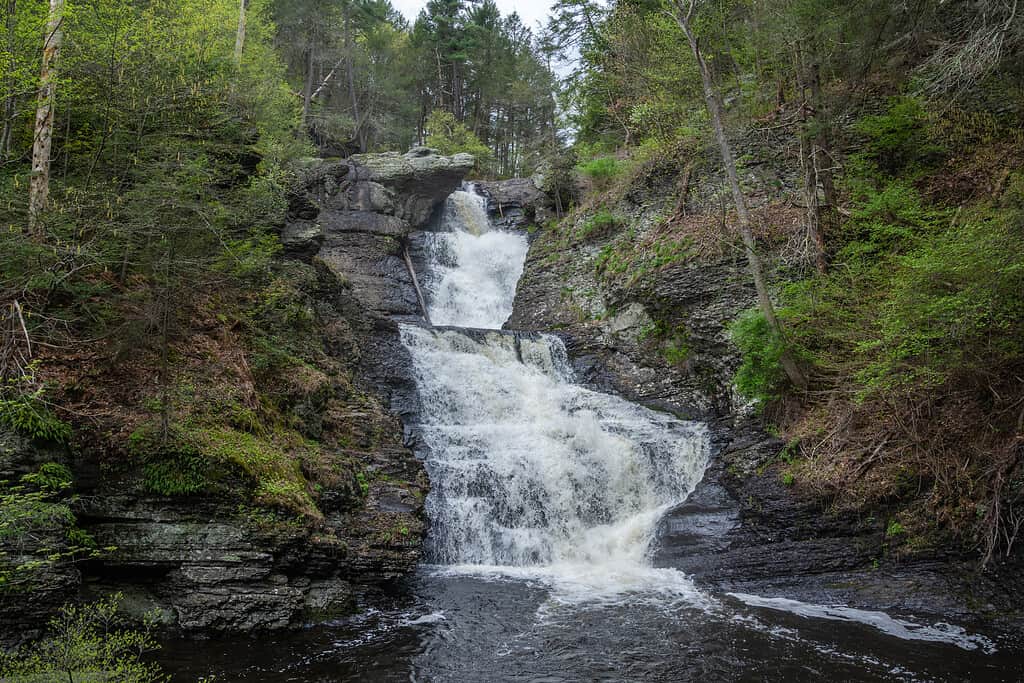
The three-tiered Raymondskill Falls can be found on the Raymondskill Creek Trail.
©iStock.com/AlizadaStudios
The cascades of Raymondskill Falls were formed by Pleistocene glaciers that moved through northern Pennsylvania. These glaciers deepened the Delaware River valley, carved the way for Raymondskill Creek, and created Raymondskill Falls.
There are two viewing platforms at the falls. One is near the head of the falls. The other is located at a large step that divides the upper two drops from the lower.
This video produced by Pocono Mountains Visitors Bureau provides a great look at the trail’s terrain as well as the views of Raymondskill Falls that await visitors at the end of the 0.3-mile hike.
The Second Highest Waterfall in the State
The Delaware Water Gap National Recreation Area is also home to Pennsylvania’s second-highest waterfall. Dingmans Falls features a 130-foot cascade. From the Raymondskill Creek Trailhead, visitors only need to take a short jaunt down Route 209 to arrive at Dingmans Creek Trail. Unlike Raymondskill Creek Trail, this trail is wheelchair accessible, so everyone can enjoy Dingmans Falls. They may be the second-tallest in the state, but these falls certainly do not provide a second-place viewing experience!
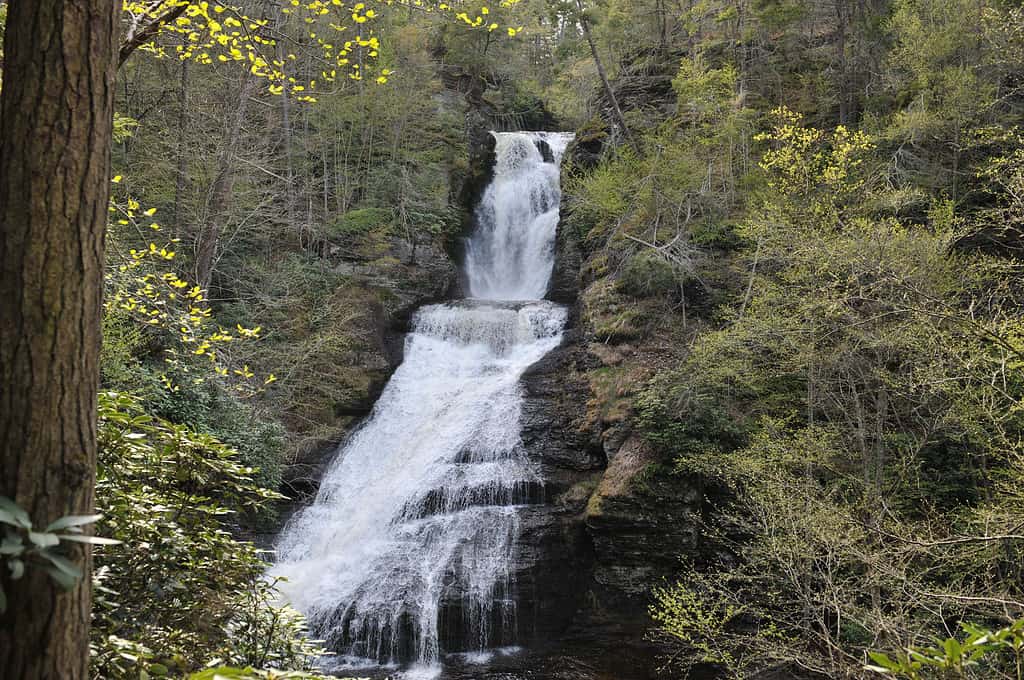
Dingmans Falls is the second-tallest waterfall in Pennsylvania and is also found in the Delaware Water Gap National Recreation Area.
©iStock.com/Wirestock
Other Waterfalls of the Poconos
Along with the two highest waterfalls in Pennsylvania, the Pocono Mountains feature other stunning waterfalls, such as Bushkill Falls (located just outside the Delaware Water Gap National Recreation Area), Shohola Falls, and Paupack Falls, among others.
Wildlife Around Raymondskill Falls
The Delaware Water Gap National Recreation Area is smack in the middle of the most densely populated area in the U.S. Yet, this Pennsylvania and New Jersey treasure abounds with wildlife. While hiking to Raymondskill Falls or exploring other regions of this federally-protected area, guests can view a variety of mammals, birds, and more.
Black Bears
Many black bears call the park home. In fact, this national recreation area has one of the densest populations of black bears in the U.S. It also boasts some of the largest black bears in the nation. Picnicking is a popular pastime in the park. Picnickers must remember to clean up all scraps, including napkins and plates. Once a bear equates humans with a potential food source, things get dangerous for both humans and the bear. It can lead to more aggressive behavior, which may require the bear to be killed. Remember, a fed bear is a dead bear!

The Delaware Water Gap National Recreation Area is home to some of the largest black bears in the United States.
©Elizabeth Caron/Shutterstock.com
Other Animals
White-tail deer also proliferate the park. They can be seen munching on the flora along many of the trails in the recreation area, including the Raymondskill Creek Trail.
Along with deer, wild turkeys are also often sighted within the park. Flocks can be seen searching for food throughout the recreation area.
When canoeing or strolling beside the park’s waterways, keep an eye out for beavers, minks, and muskrats. Great blue and green herons wade in shallows looking for a meal of fish, frogs, and crustaceans. If you are fortunate, you might even see some river otters at play during your visit to the Delaware Water Gap National Recreation Area.
At night, a whole new host of animals emerge. Under the cover of darkness, gray foxes, bobcats, and coyotes stalk the park for prey. Owls emerge to hunt for mice and other small mammals. Six species of bats take to the night sky over the park hunting mosquitoes, moths, and other insects.
Fishing
The wildlife of the park also includes a myriad of fish. The Middle Delaware River and its tributaries within the recreation area teem with 61 species of fish. Anglers can target the many game fish in the Delaware Water Gap area, including native species such as American shad, brook trout, yellow perch, and pumpkinseed.
The game fish also include species that are native to North America. They were probably introduced to these waters before the creation of the national recreation area in 1965. Those species include fish such as rainbow trout, smallmouth bass, largemouth bass, bluegill, green sunfish, black crappie, channel catfish, walleye, and muskellunge.

The Delaware Water Gap National Recreation Area is an outstanding fishery for smallmouth bass, along with many other game fish.
©CLP Media/Shutterstock.com
There are also three fish species considered invasive in these waters: the common carp (native to Asia and Europe), goldfish (native to Asia), and brown trout (native to Europe).
The Delaware Water Gap area is a gem for anglers who live in this highly populated area. If you head to the area with your rod and reel, remember this recreation area is located in two states. You can’t use a New Jersey fishing license to fish Pennsylvania waters and vice versa, even on federally-managed land such as the Delaware Water Gap National Recreation Area.
Camping
The park has three developed campgrounds, including Dingmans Campground, which can accommodate RVs. This campground is a short ten-minute drive from the Raymondskill Creek Trail, making it a great place to stay when you venture out to visit Pennsylvania’s tallest waterfall.
There are also 62 river campsites that are only accessible via canoe or kayak. These sites will immerse campers in the natural setting of the Delaware Water Gap National Recreation Area. Visitors can fish from the campsite to catch a delicious dinner. Then they can spend the evening basking in the serenity of the sounds from the flowing river, the calls of tree frogs, and the hooting of owls.
Pennsylvania’s tallest waterfall, Raymondskill Falls, is surrounded by a fabulous natural habitat in the middle of a highly populated region. It is a treasure that ought not to be missed!
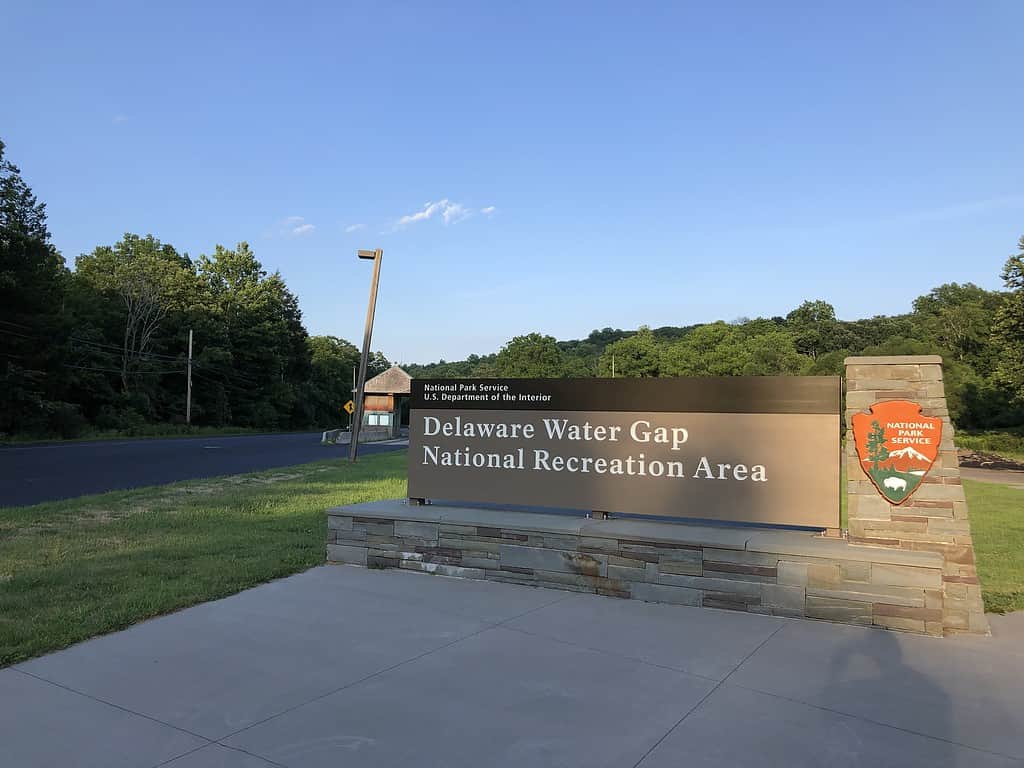
The Delaware Water Gap National Recreation Area is a natural gem that includes the tallest waterfall in Pennsylvania: Raymondskill Falls.
©Famartin / CC BY-SA 4.0 – License
Where Is Raymondskill Falls Located on a Map?
Part of the Delaware Water Gap National Recreation Area, Raymondskill Falls is in Pike County and is Pennsylvania’s tallest waterfall. It is actually a three-tiered series of waterfalls located on Raymondskill Creek, which is in the state’s famous Pocono Mountains region. It also is close to the New Jersey border.
The photo featured at the top of this post is © ALaPhoto/Shutterstock.com
Thank you for reading! Have some feedback for us? Contact the AZ Animals editorial team.





